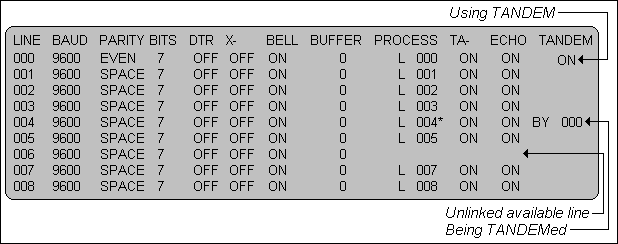
The LIST-LINE-CHARS command displays information about the configuration of all communications lines and system processes. The displayed report also includes transmission characteristics and protocols for each line.
Format
LIST-LINE-CHARS [line1 [–line2]] [(options)] |
Parameter(s)
line1 |
Line you want information about. |
|
line1-line2 |
Specifies a range of lines. |
|
options |
The following options are supported: |
|
N |
Suppresses end-of-page breaks. |
|
P |
Sends the report to the printer. |
|
Description
The Lines Configuration Report looks like this:

The Lines Configuration Report
The report contains the following information:
LINE |
Number of the communications line. |
|
BAUD |
Baud rate for each line. |
|
PARITY |
Parity setting for each line. |
|
BITS |
Number of data bits sent. |
|
DTR |
Indicates whether or not a DTR (Data Terminal Ready) signal will be detected on the line. |
|
X- |
Indicates whether the X-ON/X-OFF protocol is enabled or disabled. There are four possible statuses: |
|
IN |
Inward X-ON protocol is ENABLED. |
|
OUT |
Outward X-ON protocol is ENABLED. |
|
I/O |
Inward and outward X-ON protocols are ENABLED. |
|
OFF |
Inward and outward X-ON protocols are DISABLED. |
|
BELL |
Indicates whether the bell signal is enabled or disabled. |
|
BUFFER |
Lists the number of characters that are currently in the type-ahead buffer for each line. The maximum number is 127. A W indicates that the type-ahead wrap option is enabled. |
|
PROCESS |
Lists the process that is linked (L), or attached (A) to each line. If no process is listed, the line is available. An asterisk (*) indicates your own process. Two or more asterisks indicate that your process is attached to a line or lines in addition to the line linked to your process at coldstart. |
|
TA- |
Indicates whether the type-ahead function is ON or OFF. |
|
ECHO |
Indicates whether the echo function is ON or OFF. |
|
TANDEM |
Lists the processes that are associated with each other through the TANDEM command. The originating process is indicated by ON; the destination process is indicated by BY number, number being the number of the originating process. |
|